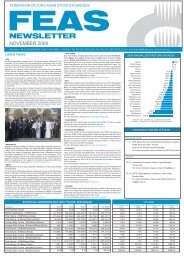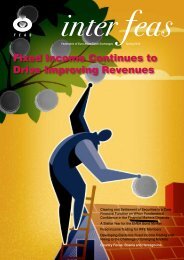Download - FEAS xxx.fh9
Download - FEAS xxx.fh9
Download - FEAS xxx.fh9
Create successful ePaper yourself
Turn your PDF publications into a flip-book with our unique Google optimized e-Paper software.
FEDERATION OF EURO-ASIAN STOCK EXCHANGES SEMI ANNUAL REPORT MAY 2005<br />
STATE COMMODITY & RAW MATERIALS EXCHANGE OF TURKMENISTAN<br />
ECONOMIC AND POLITICAL DEVELOPMENTS<br />
Politic and Economic Environment:<br />
Turkmenistan, continues to formulate<br />
ambitious national development projects, the<br />
funding of which will largely be determined<br />
by the country's ability to monetize its worldclass<br />
natural gas reserves of some 100<br />
trillion cubic feet (2.9 trillion cubic meters)<br />
with more likely still to be found. With the<br />
completion of the Korpezhe-Kurt Kui pipeline<br />
to Iran, the first gas pipeline from Central<br />
Asia not to cross Russia, gas exports are not<br />
totally dependent on Russia and Ukraine.<br />
But, the vast majority of Turkmenistan's gas<br />
production, about 80%, still moves through<br />
Russian pipelines.<br />
Turkmenistan possesses considerable<br />
natural resources despite the fact that the<br />
Kara Kum Desert covers 80% of the country.<br />
Exploitation of gas reserves (the fourth<br />
largest in the world) has been severely<br />
impaired by Turkmenistan's inability to<br />
access Western markets for its gas.<br />
Turkmenistan has a wide range of other<br />
industrial minerals including the world's third<br />
largest sulfur deposit. While less than 5% of<br />
Turkmenistan is utilized for agricultural<br />
production, cotton is a major export crop<br />
and the sector employs nearly half of the<br />
work force. Turkmenistan's agricultural sector<br />
has the productive potential to export a<br />
variety of products. As such, the government<br />
is currently promoting the textile and food<br />
processing industries and has initiated a<br />
number of transportation infrastructure<br />
projects. The private sector is estimated to<br />
contribute approximately 30% to the annual<br />
ECONOMIC RATIOS<br />
Domestic<br />
savings<br />
Turkmenistan<br />
Lower-middle-income group<br />
Trade<br />
Indebtedness<br />
Investment<br />
GDP. Recent robust economic growth<br />
suggests that Turkmenistan will likely delay<br />
any further privatization among the larger<br />
state-owned enterprises (SOEs) and the<br />
financial sector.<br />
After independence in 1991, Saparmurat<br />
Niyazov, head of the Communist Party of<br />
Turkmenistan since 1985, and president<br />
since October 1990 when the post was<br />
created, was elected president of the new<br />
country in a direct election on June 21, 1992.<br />
Running unchallenged, he was elected with<br />
a reported 99.5% of the vote. In a Jan. 15,<br />
1994 referendum, a reported 99.99% of the<br />
electorate voted to extend Niyazov's term in<br />
office, which had been set expire in 1997,<br />
until the year 2002. This measure was<br />
undertaken in response to a motion by the<br />
leaders of the DPT that he be appointed<br />
"president for life." President Saparmurat<br />
Niyazov announced on Feb. 16, 2001, his<br />
intention to hold presidential elections in<br />
2010, although he was named<br />
Turkmenistan's president for life two<br />
years ago.<br />
GROWTH OF INVESTMENT AND GDP<br />
(%)<br />
25<br />
20<br />
15<br />
10<br />
5<br />
0<br />
-5<br />
-10<br />
-15<br />
97<br />
GDI GDP<br />
Economic Performance:<br />
In an effort to combat a number of<br />
consecutive years of hyperinflation, the<br />
government in 1996-1997 restrained budget<br />
deficits, tightened credit and eased currency<br />
controls in accordance with IMF<br />
recommendations. Inflation (as measured by<br />
the GDP deflator) was reduced from over<br />
1,000% to under approximately 35% by 1998<br />
and then declined further to 9.1% by yearend<br />
2003. Fiscal deficits have been quite<br />
small since the resumption of normal<br />
production of natural gas; the deficit in 2003<br />
is estimated to have been just 0.9% of GDP,<br />
basically in line with numbers posted for the<br />
last few years.<br />
The 2003 current account recorded a surplus<br />
of 1.3% of GDP, unchanged from 2002, due<br />
to strong growth in natural gas production.<br />
With continued growth in this sector,<br />
Turkmenistan anticipates more robust<br />
merchandise trade and current account<br />
surpluses in coming years. The government<br />
reported, FDI of US$ 51 million during the<br />
first four months of 2000. Production sharing<br />
contracts with international oil and gas<br />
production companies are the vehicle by<br />
which the government hopes to boost the<br />
current low level of foreign investment. 1<br />
1 Economic and Political Overview, County Watch<br />
Incorporated, 2005<br />
98 99 00 01 02 03<br />
* World Bank reports<br />
PAGE 117
















